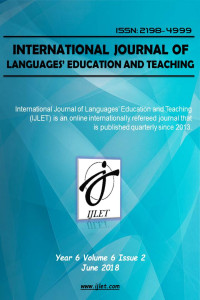Öz
The purpose of this article is to introduce gerunds in Turkish of Turkey to francophones who are trying to learn this language. The Turkish language is an Uralo-Altaic language; because of its typological structure it is agglutinative. The user of one of the Indo-European languages would find himself compelled to face a great number of dissimilarities which seemed to him incomprehensible. This text is intended to show them some gerunds by its many aspects ... This category of Turkish grammar encompass a quantity of morpheme and lexie. Their formations and the functions they assume in sentences would suffice to demonstrate the original richness of Turkish. Certainly, the originality lies in the picturesque language. Each of the languages unveiled by the beginner or the false beginner opens before his eyes new surprising fields. The pre-advanced or advanced learner goes beyond the discovered beauties, he goes on to explore the subtleties of the target language. This article is addressed to the latter, does not neglect to remind all those who have been interested in Turkish some preliminary concepts and terms in Turkish, as well as their pronunciations. It would be desirable to grow the curiosity of the first ... Besides the pleasure of learning a language "very" foreign, we often dream to make translations. The translation of the foreign language into the mother tongue and the translation from the mother tongue to the foreign language would require grammatical knowledge. This article proposes to be useful to learners and to translators.
Anahtar Kelimeler
Turkish grammar Gerunds participle Learning Turkish Translation and interpretation
Kaynakça
- Altınkaynak, H. (Haz.) (2010). Türk Dili 1-2 Üniversite Öğrencisinin Ders Kitabı. İstanbul: SomKitap.
- Banguoğlu, T. (1974). Türkçenin Grameri. İstanbul: Baha Matbaası.
- Dizdaroğlu, H. (1976). Tümcebilgisi. Ankara: Türk Dil Kurumu Yayınları.
- Ediskun, H. & Dürder, B. (1982). Örnek Dilbilgisi (Lise 1-2-3). İstanbul: Remzi Kitabevi.
- Gencan, T. N. (1979). Dilbilgisi. Ankara: Türk Dil Kurumu Yayınları.
- Mauger, G. (1977). Grammaire pratique du français d’aujourd’hui. Paris: Hachette.
- Vardar, B. (Yön.) (1998). Açıklamalı Dilbilim Terimleri Sözlüğü. İstanbul: ABC Kitabevi A.Ş.
Öz
Cet article a pour but de faire connaître les gérondifs dans le turc de Turquie aux francophones qui essayent de l’apprendre. Le turc est une langue ouralo-altaïque, par sa structure typologique elle est agglutinante. L’usager d’une des langues indo-européennes se trouverait contraint devant des dissemblances qui lui paraîtraient incompréhensibles. Ce texte est destiné à montrer certains gérondifs… Cette catégorie de la grammaire turque englobe des morphèmes et des lexies. Leurs formations et fonctions dans des phrases suffiraient à démontrer l’originalité du turc. L’originalité réside dans le pittoresque linguistique. Des langues mi-dévoilées par le débutant ou le faux débutant ouvrent de nouveaux champs. L’apprenant avancé passe au-delà, il va à l’exploration des subtilités de la langue cible. Cet article s’adressant plutôt aux pré-avancés et aux avancés, ne néglige pas de rappeler à ceux qui s’intéressent au turc des notions préliminaires ainsi que des prononciations. Il serait ainsi souhaitable de croître la curiosité des premiers... Outre le plaisir d’apprendre une langue « très » étrangère, on rêve souvent d’en faire des versions et des thèmes. Dès lors, les traductions en deux sens exigeraient des connaissances grammaticales. Cet article se propose d’être utile, en gérondifs, aux apprenants du turc.
Anahtar Kelimeler
La grammaire turque les gérondifs les participes l’apprentissage du turc la traduction
Kaynakça
- Altınkaynak, H. (Haz.) (2010). Türk Dili 1-2 Üniversite Öğrencisinin Ders Kitabı. İstanbul: SomKitap.
- Banguoğlu, T. (1974). Türkçenin Grameri. İstanbul: Baha Matbaası.
- Dizdaroğlu, H. (1976). Tümcebilgisi. Ankara: Türk Dil Kurumu Yayınları.
- Ediskun, H. & Dürder, B. (1982). Örnek Dilbilgisi (Lise 1-2-3). İstanbul: Remzi Kitabevi.
- Gencan, T. N. (1979). Dilbilgisi. Ankara: Türk Dil Kurumu Yayınları.
- Mauger, G. (1977). Grammaire pratique du français d’aujourd’hui. Paris: Hachette.
- Vardar, B. (Yön.) (1998). Açıklamalı Dilbilim Terimleri Sözlüğü. İstanbul: ABC Kitabevi A.Ş.
Öz
Anahtar Kelimeler
La grammaire turque les gérondifs les participes l’apprentissage du turc la traduction
Kaynakça
- Altınkaynak, H. (Haz.) (2010). Türk Dili 1-2 Üniversite Öğrencisinin Ders Kitabı. İstanbul: SomKitap.
- Banguoğlu, T. (1974). Türkçenin Grameri. İstanbul: Baha Matbaası.
- Dizdaroğlu, H. (1976). Tümcebilgisi. Ankara: Türk Dil Kurumu Yayınları.
- Ediskun, H. & Dürder, B. (1982). Örnek Dilbilgisi (Lise 1-2-3). İstanbul: Remzi Kitabevi.
- Gencan, T. N. (1979). Dilbilgisi. Ankara: Türk Dil Kurumu Yayınları.
- Mauger, G. (1977). Grammaire pratique du français d’aujourd’hui. Paris: Hachette.
- Vardar, B. (Yön.) (1998). Açıklamalı Dilbilim Terimleri Sözlüğü. İstanbul: ABC Kitabevi A.Ş.
Ayrıntılar
| Birincil Dil | Fransızca |
|---|---|
| Konular | Dilbilim (Diğer), Türk Dili ve Edebiyatı (Diğer) |
| Bölüm | Araştırma Makalesi |
| Yazarlar | |
| Yayımlanma Tarihi | 30 Haziran 2018 |
| Yayımlandığı Sayı | Yıl 2018 Cilt: 6 Sayı: 2 |


